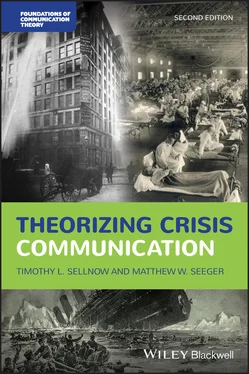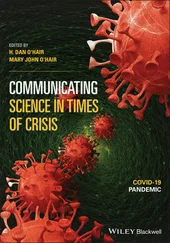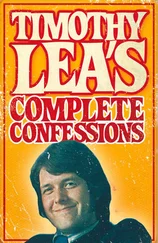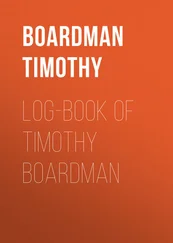From other perspectives, the question of the magnitude of a crisis is best understood as a matter of personal, community, and even cultural perception. Not surprisingly, people are more likely to understand an event as a crisis when it affects them. Coombs (2010) describes a crisis as a function of perceptions based on a violation of some strongly held expectation. Food, for example, should be safe to eat and free of harmful E. coli contamination. Tap water should be safe to drink. It is generally expected that rivers will remain within defined areas and not spread to inundate residential or downtown areas. Seasonal influenza should be a relatively minor disorder and should not create widespread illness, death, and social disruptions. The violation of these expectations and some level of community and social consensus about the relative level of risk and threat create the perception of a crisis. A crisis condition is in contrast to what would be considered a normal condition. When people believe there is a crisis, they are likely to behave differently than they would in so-called normal times.
Similar debates about definitions have also focused on the notion of the intentional creation of harm. For example, some scholars have argued that international conflicts between countries represent crises, while others have suggested that war itself should not be classified as a crisis, although the consequences, such as the dislocation of populations, disruption of food supplies, or disease outbreaks, do represent crises. War usually but not always is the outcome of some extended conflict and as such is not surprising in the same way as most crises. Terrorism attacks are intentional, unanticipated, and surprising and are generally classified as crisis events.
Table 1.2 Typologies of Crisis.
| Crisis Types: |
| Lerbinger (1997) |
Seeger et al. (2003) |
Coombs (2010) |
| Natural disaster |
Public perception |
Natural disasters |
| Technological crises |
Natural disasters |
Malevolence |
| Confrontation |
Product or service crisis |
Technical breakdowns |
| Malevolence |
Terrorist attack |
Human breakdowns |
| Organizational misdeeds |
Economic crisis |
Challenges |
| Workplace violence |
Human resource crisis |
Mega-damage |
| Rumors |
Industrial crisis |
Organizational misdeeds |
| Terrorist attacks/man-made disasters |
Spills (oil, chemical) |
Workplace violence |
| Crises from environmental factors |
Transportation disasters |
Rumor |
These various crises all generally evoke the notion of some dramatic, unanticipated threat with widespread and wholly negative impact. Events such as the Japanese tsunami and Fukushima nuclear accident, the Challenger Shuttle disaster, the British Petroleum (BP) Gulf oil spill, and the anthrax letter contamination episode represent crises. These events share three general attributes: they are largely unanticipated or violate expectations; they threaten high-priority goals, and they require relatively rapid response to contain or mitigate the harm (Hermann, 1963; Seeger et al., 2003). Crises are almost always unanticipated by key stakeholders, although there are usually warning signs and cues. Most often, they involve a radical departure from the status quo and a violation of general assumptions and expectations, disrupting “normal” and limiting the ability to anticipate and predict. The severe violation of expectations is usually a source of uncertainty, psychological discomfort, and stress. Sometimes, the occurrences are so confusing people simply do not know what to do and experience extreme psychological dislocation. Weick has described this response as a cosmological episode: “When people suddenly and deeply feel that the universe is no longer a rational, orderly system. What makes an episode so shattering is that both the sense of what is occurring and the means to rebuild that sense collapse together” (Weick, 1993, p. 633).
Significant threats to such high-priority goals as life, property, security, health, and psychological stability are often associated with crises. These threats also create severe anxiety and stress and the need to do something, that is, to take some action in response to the threat. This reaction is sometimes described as the fight or flight response, a natural neurological response first described by psychologist Walter Cannon in the 1920s. The primary mammalian stress hormone, adrenaline, is activated when a threatening situation is faced. This hormone produces several neurological responses, including increased heart rate, constricted blood vessels, and dilated air passages. In general, these responses enhance an organism’s physical capacity to respond to a threatening situation. Gray (1988) updated the fight or flight framework into a more comprehensive four-stage process of “freeze, flight, fight, and fright.” Initially, an organism may exhibit a freeze response, exhibiting hypervigilance or awareness to the threat. The second response, according to Gray, is to flee, and if this is not an option or if fleeing is exhausted as a strategy, a fight response is activated. Finally, a strategy of fright, freezing, or immobility may occur as the organism “plays dead” in a final effort to avoid the threat.
A third defining condition of crisis is that the event usually requires some immediate action or response by agencies and groups to limit and contain the harm. Actions such as shelter-in-place or evacuation are common for some kinds of events. During the 2009 H1N1 influenza pandemic, the Centers for Disease Control and Prevention (CDC) recommended members of the public get vaccinations, wash their hands frequently, cover their cough, and stay home when sick. These actions are mitigation strategies designed to limit the spread of the disease. In cases of contaminated products, avoiding the product is necessary to reduce harm. Power outages, heavy rains, or floods often contaminate municipal water supplies. In these cases, water must be disinfected through actions such as boiling to avoid waterborne diseases. These actions usually require some communication of expert or situational advice. The need for a rapid response implies that crises emerge quickly and are of relatively short duration. This is not always the case. The consequences of a crisis can emerge slowly over time and last for very long durations. Environmental crises, for example, may be years, even decades in the making and the consequences may only become clear slowly over time. Chemical contamination is an especially challenging source of slow-moving crises. With over 50,000 known landfill sites with toxic chemicals, these legacy “time bombs” have the potential to slowly yet significantly impact human health for years and even decades (Worthley & Torkelson, 1981).
We have suggested elsewhere that a crisis may be defined as a specific, unexpected, non-routine event or series of events that creates high levels of uncertainty and a significant or perceived threat to high-priority goals (Seeger et al., 2003). This definition captures the three primary conditions of crisis and suggests a crisis may be a contained, single event such as the 27 April 2011, Tuscaloosa, Alabama, tornado in which 52 people died, or it may be a series of interacting and cascading events, such as the Fukushima earthquake, tsunami, and nuclear disaster. This definition also includes the idea that a crisis should be contained or specific in its parameters. Larger issues, such as the ongoing healthcare crisis or the energy crisis, would not meet this definition.
Others have offered more straightforward crisis definitions. Heath (1995), for example, suggests that a crisis is a risk manifest. From this perspective, a risk occurs before a crisis and is the consequence of a risk continuing to develop without appropriate efforts to manage it. This notion of a risk incubating, developing unchecked, and perhaps interacting with other factors is one of the most common views of a crisis “cause.” Therefore, crisis is also closely related to the concept of risk. Risk communication generally concerns “risk estimates, whether they are appropriate, tolerable, and risk consequences” (Heath, 1995, p. 257). Birkland (1968) described crises as focusing events, bringing attention to issues and setting the larger public policy agenda. Thus, a crisis can be a significant force in political and social change and may determine what actions government might take.
Читать дальше












